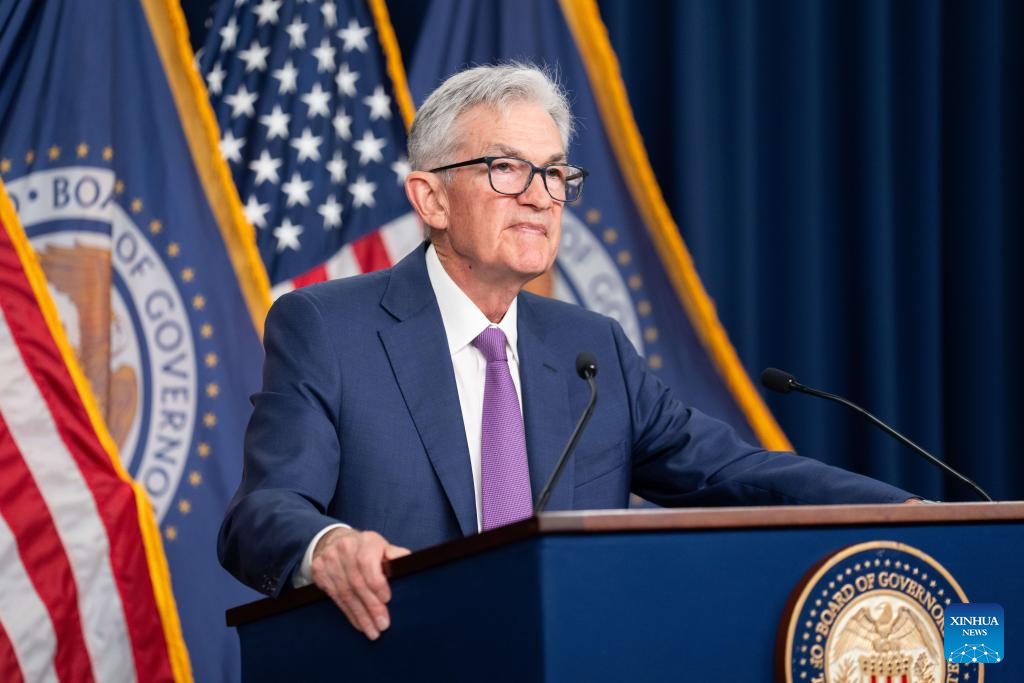Your current location:HOME >opinions >US Fed keeps interest rates unchanged at 5.25 正文
TIME:2024-05-03 09:34:06 Source: Internet compilationEdit:opinions
The U.S. Federal Reserve on Wednesday left interest rates unchanged at a 22-year high of 5.25 percen
The U.S. Federal Reserve on Wednesday left interest rates unchanged at a 22-year high of 5.25 percent to 5.5 percent as recent consumer data indicates that inflation continued to tick up.

U.S. Federal Reserve Chair Jerome Powell attends a press conference in Washington, D.C., the United States, on May 1, 2024. (Xinhua/Liu Jie)
The central bank's latest decision came just a few days after the Commerce Department reported on Friday that the U.S. personal consumption expenditures (PCE) price index, the Fed's preferred inflation measure, ticked up to 2.7 percent in March.
Amid stubborn inflation that shows no sign of abating, U.S. gross domestic product (GDP) growth slowed significantly to an annual rate of 1.6 percent in the first quarter, marking a sharp drop from the 3.4 percent in the fourth quarter, according to data released last week.
The report also showed that the PCE price index grew 3.4 percent in this year's first three months, a significant uptick from the 1.8 percent rise in last year's final quarter.
"We don't like to react to one or two months' data. But this is a full quarter. We are taking signal. And the signal we're taking is it's likely to take longer for us to gain confidence that we're on a sustainable path to 2 percent inflation," Federal Reserve Chair Jerome Powell told reporters at a press conference Wednesday afternoon after the Fed's two-day policy meeting.
"Inflation has eased over the past year but remains elevated. In recent months, there has been a lack of further progress toward the Committee's 2 percent inflation objective," the Federal Open Market Committee (FOMC), the Fed's policy-setting body, said in a statement.
"The economic outlook is uncertain, and the Committee remains highly attentive to inflation risks," the statement read.
At the press conference, Powell refrained from commenting on whether three rate cuts are still possible this year. While this was the Federal Reserve's projection back in March, market participants are now anticipating a lesser number of reductions.
There is currently a roughly 43.6 percent chance of the Fed cutting rates in November versus a 33.6 percent chance of another pause, according to the CME FedWatch Tool.
The Fed chief dismissed the stagflation concern. "I was around for stagflation. It was 10 percent unemployment. It was high single digit inflation. And very slow growth," Powell said.
"Right now we have 3 percent growth, which is pretty solid growth ... And we have inflation running under 3 percent. So I don't really understand where that's coming from," he said.
Powell said he thinks it's "unlikely" that the next policy rate move will be a hike. "The policy focus ... has really been on what to do about holding the current level of restriction," he said.
Beginning in June, the Fed will slow the pace of decline of its securities holdings by reducing the monthly redemption cap on Treasury securities from 60 billion U.S. dollars to 25 billion dollars, the FOMC statement noted.
The Committee will maintain the monthly redemption cap on agency debt and agency mortgage-backed securities at 35 billion dollars and will reinvest any principal payments in excess of this cap into Treasury securities, it added.
The latest announcement shows that the Fed has declared its intention to gradually decrease the amount of bonds it's currently selling off from its balance sheet, ultimately culminating in the cessation of the process known as "quantitative tightening."
"A decision to slow the pace of run-off does not mean that our balance sheet will ultimately shrink by less than it would otherwise, but rather allows us to approach its ultimate level more gradually," Powell said.
"In particular, slowing the pace of run-off will help ensure a smooth transition, reducing the possibility that money markets experience stress, and thereby ensuring our holdings that are consistent with reaching the level of ample reserves," he said.
World's largest plant discovered off Australian coast2024-05-03 09:29
Mom who took her one2024-05-03 09:06
Kim Kardashian is surprised by Jimmy Kimmel Live's Guillermo as he models her SKIMS shapewear2024-05-03 08:55
United Methodists open first top2024-05-03 08:16
Scottish government survives vote of no confidence2024-05-03 07:39
Myanmar junta chief missing from public view after drone attack — Radio Free Asia2024-05-03 07:14
Mississippi lawmakers move toward restoring voting rights to 32 felons2024-05-03 07:13
Global plastic treaty: Negotiations hit critical stage in Canada2024-05-03 07:03
Shanghai boosts services for inbound travelers2024-05-03 06:52
Global plastic treaty: Negotiations hit critical stage in Canada2024-05-03 06:49
Over 1,000 arrested in US college protests nationwide2024-05-03 09:33
Olympic gold medalist Allisha Gray hopes to be part of US 3x3 team in Paris Games2024-05-03 09:04
Taylor Swift's former boyfriends have ended up marrying Swifties2024-05-03 09:00
Nelly Korda puts six2024-05-03 08:53
China expects 210 mln road passenger trips during National Day holiday2024-05-03 08:41
Meg Bennett dead at 75 following cancer battle: Emmy2024-05-03 08:37
Why Meghan's podcast has hit a snag before it even begins: Duchess's much2024-05-03 08:34
Look what you made me do! Taylor Swift famously uses her mega2024-05-03 08:26
Landmark Google antitrust case ready to conclude2024-05-03 07:44
Luke Bryan takes a surprise tumble on stage in Vancouver2024-05-03 07:10